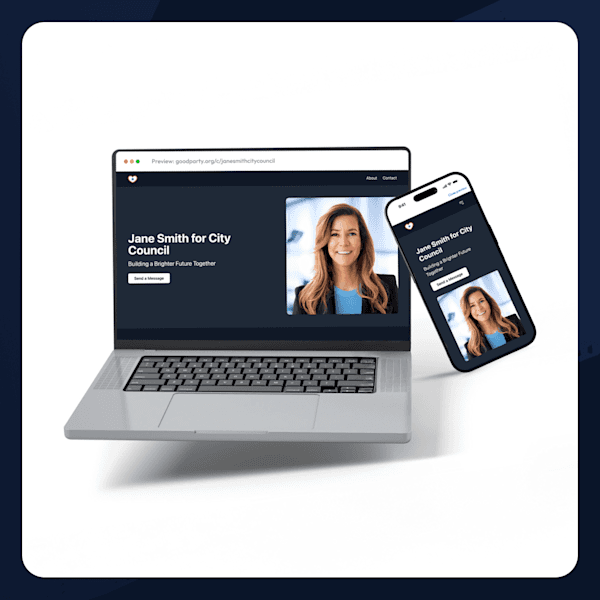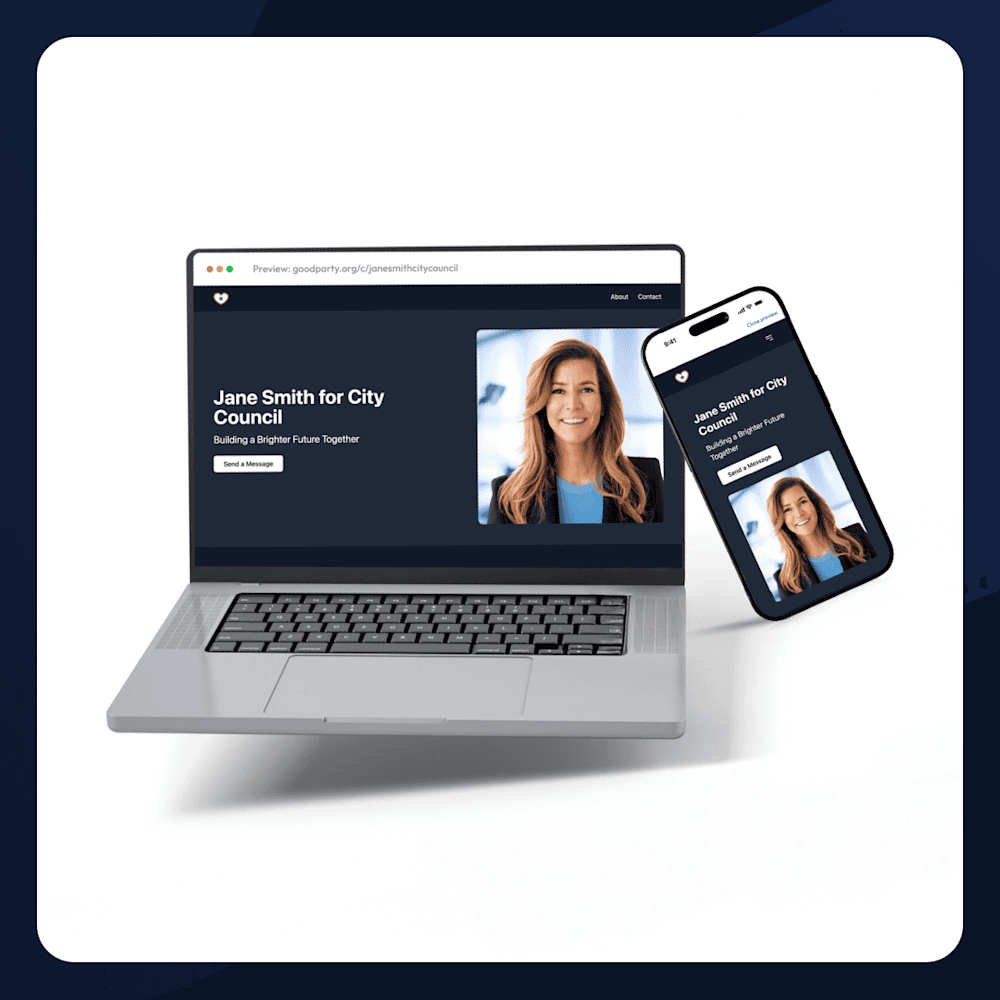
What Are Political Fundraising Platforms? Types & Strategies
Online fundraising has changed the rules of political campaigning. What used to take months of phone calls and in-person events can now happen in hours, powered by everyday people giving what they can, from wherever they are.
Today’s political fundraising platforms are engines of grassroots democracy, helping local, nonpartisan, and Independent candidates reach voters effectively, raise money transparently, and compete with better-funded, party-backed campaigns.
In this guide, we’ll break down how political fundraising platforms work, the main types to know, and how to use them to fund your run.
What Is a Political Fundraising Platform?
A political fundraising platform is a digital tool that lets campaigns collect and manage donations online. These platforms make it simple for voters to contribute while helping candidates stay compliant, track data, and build lasting relationships with donors.
Unlike traditional fundraising methods that rely on big checks and in-person events, online platforms make political fundraising faster, more transparent, and more inclusive. Supporters can donate from anywhere, on any device, often in just a few clicks.
For Independent and third-party candidates, online fundraising platforms level the playing field. They give you the same tools used by major campaigns without needing party infrastructure or expensive consultants.
LEARN MORE: Start building your campaign’s bank with our guide to political fundraising.
Types of Political Fundraising Platforms
Not every fundraising platform is the same. Some focus on peer-to-peer engagement, while others specialize in mobile giving or comprehensive campaign management. Here are the main types of tools you should know.
#1: Crowdfunding Platforms
Crowdfunding platforms let candidates raise small-dollar donations from many supporters. These platforms make it easy to share your story and funding goal, encouraging people to contribute even modest amounts that add up fast.
Crowdfunding platforms are typically best for grassroots candidates and first-time campaigns. Crowdfunding works especially well for Independent campaigns that rely on local supporters rather than PAC money or party donors.
Examples of commonly used platforms include GoFundMe, Fundly, and Givebutter, which offer simple donation pages, campaign updates, and social sharing features.
LEARN MORE: Explore how to use crowdfunding to build grassroots support.
#2: Peer-to-Peer Fundraising Platforms
Peer-to-peer (P2P) fundraising platforms empower supporters to fundraise on your behalf. Volunteers can create their own donation pages and share them with friends, family, and social networks.
If your campaign already has a strong volunteer network, a P2P platform might work best for you. These platforms expand your reach exponentially, turning every supporter into a mini-campaign ambassador.
Some popular peer-to-peer platforms include Classy, DonorDrive, and Qgiv. Some, like Givebutter, combine crowdfunding and P2P features to maximize your reach.
#3: All-in-One Fundraising Platforms
All-in-one political fundraising platforms combine donation processing, donor management, and event ticketing into a single system. They can also integrate with other campaign tools, like your email marketing or voter outreach software.
If you’re growing your campaign and want centralized tools to simplify the process, an all-in-one platform can give you the ease and reach you need.
Common options include NationBuilder, NGP VAN, and ISPolitical, though many are designed exclusively for Democratic or Republican campaigns. Anedot, on the other hand, is a popular nonpartisan fundraising platform used by Independent candidates, local campaigns, and small organizations.
Independent candidates can also create similar setups for themselves by linking tools like Ecanvasser and Givebutter for seamless operations across fundraising, field, and digital outreach.
LEARN MORE: Check out our picks for the top political campaign software for Independent and local campaigns.
#4: Mobile and Text-to-Donate Apps
With mobile giving, donors can contribute instantly from their phones. These platforms are perfect for rallies, livestreams, or volunteer events.
Apps like Snowball, Tatango, and Qgiv let you accept donations through text messages or mobile-friendly links. Many include features like automatic receipts, donation tracking, and integration with email or CRM tools.
Given that most voters now access the internet primarily on mobile devices, optimizing for mobile giving is essential.
How to Choose the Right Political Fundraising Platform
Not every campaign needs the same tools, and with dozens of fundraising platforms out there, choosing the right one can feel overwhelming. The best political fundraising platform for your campaign will fit your goals, budget, and level of experience.
When comparing your options, look for:
Ease of Use: Choose a platform that’s intuitive for both your team and your donors. A clean, mobile-friendly interface makes it more likely that supporters will complete their donations.
Transparent Pricing: Look closely at transaction fees, subscription costs, and processing rates.
Customization Options: The ability to personalize your donation page with campaign colors, photos, and messaging helps build credibility and trust.
Integration Capabilities: If you’re using other campaign tools like a CRM, email system, or website builder, pick a platform that connects seamlessly with them. Integrations save time and reduce data-entry errors.
Compliance Features: Your platform should automatically track donations, generate contribution reports, and stay compliant with FEC and state campaign finance rules.
Donor Management Tools: Look for features that make it easy to organize donor data, segment lists, and track giving history. These tools will help you build stronger relationships over time.
Scalability: Choose a platform that can grow with you. As your campaign gains momentum, you may need to handle more donors, integrate new tools, or launch events.
Start simple. If you’re a first-time candidate, a basic crowdfunding tool or donation page may be all you need to get off the ground. You can always upgrade to an all-in-one platform once your donor base and campaign budget expand.
How to Use Political Fundraising Platforms Effectively
Choosing the right platform is only half the battle. The key is using it strategically by combining technology, storytelling, and data to build a sustainable fundraising program.
Here’s how to get the most from your political fundraising platform:
#1: Tell a Compelling Story
Donors give to people and causes they believe in. Use your platform’s campaign page to share your story clearly and authentically: why you’re running, what you stand for, and how each contribution helps.
Use visuals like photos or short videos, and keep your message consistent across your website and social media. A strong narrative turns passive visitors into active supporters.
LEARN MORE: Learn how to use storytelling effectively and get more insider tips with our free Fundraising Masterclass.
#2: Personalize Donor Outreach
Most fundraising platforms include built-in tools for email and text updates. Use them to thank supporters, share campaign milestones, and show the impact of their donations.
A short, sincere thank-you message goes a long way toward building long-term donor loyalty. You can even segment donor lists to tailor your messages by location or giving level.
#3: Combine Fundraising With Social Media
Integrate your fundraising platform with your campaign’s social channels to reach more supporters. Share donation links in your bios, posts, and event pages.
For example, you might pair a Facebook Live Q&A with a pinned donation link or create a TikTok video showing how grassroots donations power your campaign.
LEARN MORE: Make the most of your post by using the best social media platforms for political campaigns.
#4: Host Virtual Fundraising Events
Online events like livestream town halls, small-donor meetups, or panel discussions can build energy and raise funds at the same time.
Some fundraising platforms can even help manage RSVPs, ticket sales, and post-event follow-ups. Virtual fundraisers are especially effective for local races, where in-person gatherings may be limited by geography or budget. The more creative your fundraising efforts, the broader your reach can be.
#5: Use Analytics to Guide Your Strategy
Most political fundraising platforms include dashboards that track donation patterns, engagement rates, and conversion trends.
Review these insights regularly to see what’s working. If you notice donations spike after certain posts or emails, double down on that format. Data-driven decisions help you optimize every dollar and hour you invest.
#6: Stay Compliant and Secure
Always make sure your fundraising platform meets campaign finance and data protection standards.
Your fundraising platform should:
Automatically track and report donations
Comply with FEC limits
Use encrypted payment systems
Protecting donor data isn’t just ethical. It’s essential.
LEARN MORE: Understand how much it costs to run for office to start setting your fundraising goals.
The Future of Online Political Fundraising
The rise of AI and automation is reshaping how campaigns raise money. Predictive analytics can identify your strongest supporters, while AI chatbots can answer questions or encourage donations in real time.
Meanwhile, mobile-first giving, peer-to-peer fundraising, and digital-first campaign strategies are making it easier for small campaigns to compete with big-money operations.
As online fundraising evolves, the campaigns that succeed will be those that stay adaptable, transparent, and connected to their communities. Independent candidates who maximize their efforts with emerging technologies can stop relying on big donors or party machines. You can build your own movement, one tech-driven contribution at a time.
Photo by Ivan Samkov
Ready to start? Use GoodParty.org’s free campaign website builder to establish your digital presence and grow your base of support.

